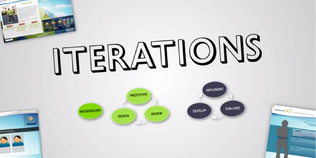Blog
Iterations: Ask, Listen, Solve Performance Problems [Ep. 9]
by Cathy Moore, guest blogger, @CatMoore


What To Do If They Want "Awareness"
By Allen Interactions | December 12, 2012 | Custom Learning | 0 Comments
 by Cathy Moore, guest blogger, @CatMoore
by Cathy Moore, guest blogger, @CatMoore
We are delighted to have Cathy Moore as a guest blogger this week. She is an international thought leader dedicated to saving the world from boring instruction. She’s a passionate advocate for improving business performance by respecting and deeply challenging learners. Her advice and designs have been used by organizations that include Microsoft, Pfizer, the US Army, Barclays, and the Federal Reserve Bank of New York. She has 29 years of experience in helping people improve their performance.
_______________________________________________________________________________
"We just need everyone to be aware of the policy," your client says. "I've sent you the 97 slides that we use in the face-to-face training. Could you have it ready by next Monday?"
Which of the following should you do next?
- Clear your schedule and open your PowerPoint converter software.
- Ask the client some questions.
 If you want to avoid creating a click-through information dump, you'll ask questions. The questions will be designed to:
If you want to avoid creating a click-through information dump, you'll ask questions. The questions will be designed to:
- Uncover the client's business goal — discover how the project will measurably change the organization's performance.
- Identify what people need to do on the job with their "awareness" and why they aren't doing it.
This information will help you design realistic, challenging activities that help learners apply the policy in ways that will improve the organization's performance.
1. Uncover the goal
To find out how your project will improve the organization's performance, try asking questions like these:
- How do you know that people aren't already aware of the policy?
- How is that lack of awareness affecting the performance or earnings of the organization?
- What are you currently measuring that could be affected by awareness of the policy? (sales, lawsuits, etc.)
- How will that measure improve when everyone is aware of the policy?
For example, a client might say that they want to "increase awareness" of the information security policy. To the above questions, they might answer:
- "We know people aren't aware of the policy because we've had some leaks of confidential information about clients and employees."
- "I guess this affects our earnings as a business — it's expensive when someone sues us, and sales could go down if customers decide they can't trust us."
- "I think the information security guys can tell us how many leaks they've seen in the last year."
- "When everyone is aware of the policy, we should have fewer leaks."
Ideally, you and the client will identify a specific change and make that your goal, such as, "Reduce information leaks 30% by 2014." "Know" or "understand" don't fit here; we're looking for observable results.
By identifying a measurable change, you aren't claiming that your course will single-handedly achieve this change. You're saying that your materials will be designed to contribute in an observable way to the change, which very likely will have non-training components as well. And, importantly, you're breaking your client's likely obsession with information presentation and making them think instead about results.
2A. Uncover what they need to DO
Once you've gotten the client to identify a measurable goal, help them identify what people need to do to reach that goal. Enlist the help of a subject matter expert who's familiar with how people are currently doing their jobs.
You might try asking questions like these:
- What are people doing wrong now, or failing to do?
- What are the most common mistakes?
- What are the most egregious mistakes?
- What do people need to do instead of what they're doing now?
When you ask, "What do people need to do?" often the client will say, "They just need to follow the policy!" But to write meaningful activities, you need more specific job tasks, such as, "They need to encrypt every email that contains a client's name and account number." Help the client or SME get this specific and prioritize the tasks to identify the most common and serious mistakes.
2B. Figure out why they aren't doing it
While you're talking about specific tasks, it's a good idea to ask why people aren't doing that task or why they're doing it wrong. Is the problem really a lack of awareness?
You can ask your client or SME to consider how the four aspects shown in this matrix affect people's performance of the task.

For example, if people aren't encrypting documents that they should encrypt, is it because they aren't aware of the rule? This would put the problem in the "knowledge" quadrant.
Or are they skipping encryption because the process is cumbersome and often results in a bizarre error message, so people in a hurry decide it isn't important enough? This would make environment and motivation more important and could inspire improvements to the encryption software.
In my experience, very few performance problems are caused purely by lack of knowledge or skills. Training is rarely a complete solution. A more complete solution often includes process or software improvements, clearer direction from managers, more fulfilling rewards for good performance, or something as simple as a quick-reference job aid for information that doesn't need to be memorized.
What's next?
By taking a couple of hours to ask these questions, you've gotten the information you need to design contextual, challenging activities that help learners practice applying what they're supposed to be "aware" of.
Now, instead of presenting the policy in a series of information screens, you can design contextual, challenging activities that require learners to make decisions and learn from the consequences. You'll be able to "test, then tell": you can first challenge the learners with a realistic decision like those they make on the job, and then you can use the consequences to reveal the necessary information.
You've also encouraged the client to focus on observable results, and you've gotten them thinking in terms of actions, not information. As a result, they'll be less likely to insist on an information dump. Your client will be eager to see (and needs to see!) quick prototypes of the activities so they understand how unlike a presentation your materials will be.
With these two steps, you're well on your way to designing activity-rich materials that could change real-world behavior. These steps are part of action mapping, a visual approach to instructional design that fits easily into the Savvy Start and SAM approaches. For more ideas like these, see Cathy's blog.
.png?width=135&height=135&name=ai-symbol-green%20(3).png)
About the Author: Allen Interactions
Comments
Would you like to leave a comment?
Related Blog Posts

By: Allen Interactions | Jul, 2013
Category: Custom Learning, Strategic Consulting

Blog
Iterations: What Makes Award-Winning e-Learning [Ep. 6]
by Cathy Moore, guest blogger, @CatMoore
By: Allen Interactions | May, 2013
Category: Custom Learning, Strategic Consulting

Blog
Iterations: 3 Ways to Implement an Elusive Savvy Start
by Cathy Moore, guest blogger, @CatMoore
By: Allen Interactions | Aug, 2014
Category: Custom Learning, Strategic Consulting
